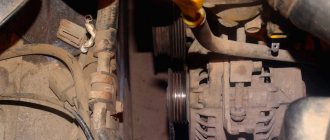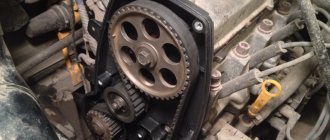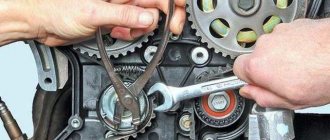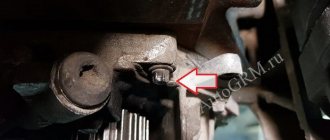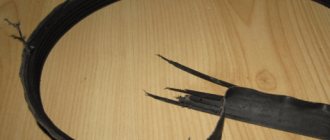A broken timing belt leads to damage to valves, and in some cases, pistons and other important engine parts. To perform a timing belt replacement, certain qualifications are required; in most cases, timing belt replacement is performed at a car service center. Replacing the timing belt yourself is only possible if the car owner has good skills and strictly follows the sequence of operations according to the car manufacturer’s instructions.
Preparing the machine and tools
Before you start work, you need to prepare everything you need in advance. This means stocking up on tools that may be needed, a new replacement kit, and also carrying out all the preparatory work.
First of all, prepare the place of work and the car itself:
- the working area must be level and normally lit;
- put the car on the parking brake;
- under the wheels - always stops;
- the engine must be completely cool;
- The car is de-energized and the battery terminals are removed.
Before starting to work on the engine itself, the car needs to be jacked up and everything that might interfere with getting to the timing belt must be removed.
List of necessary tools:
- standard set of open-end wrenches;
- a set of socket heads with a “ratchet”;
- fork key;
- a pair of screwdrivers (flat and Phillips);
- jack;
- sealant.
And finally, you need a new set of timing belt with rollers (its configuration depends on the car model), as well as clamps for the shafts (which ones depend on the engine itself, and this can be found in the service book), a flashlight, overalls, gloves and rags . And, of course, a phone with a camera, which will have to record the position of all the elements before they are dismantled. Believe me, this is important!
Step-by-step, do-it-yourself timing belt replacement
The replacement process is individual for each car model, but there is a certain algorithm of work that is typical for all cars. Clearly shown in the figure below.
Step-by-step timing belt replacement
So, everything is ready, we can start. An example is shown on 16-valve models VAZ 2110, 2111, 2112.
- First you will have to remove the alternator belt, which interferes with access to the timing belt.
Loosen the generator and remove the belt - Additional units that interfere with further work must be dismantled or moved, after loosening the fastenings. This applies, for example, to the adsorber, which may prevent the belt from being removed.
Remove the adsorber - Next, dismantle the protective covers and casings covering the timing mechanism. Their number depends on the car model: in some places everything will be limited to one casing, in others you will have to remove a dozen separate elements to get to the belt itself. The more complex the design, the more pictures you will have to take so that there are no unnecessary details left later. In this case, everything is extremely simple.
Unscrew the casing bolts - Next, you need to align the marks on the camshafts and the casing. This can be done by turning the jacked wheel, after putting it in 5th gear.
Place marks on camshafts - Also check the mark on the crankshaft.
Check the mark on the crankshaft gear - Secure the crankshaft and camshafts. To do this, you may need slats or brackets prepared in advance.
- Loosen the tension roller. To do this, you will need a hex or socket wrench, which moves the roller to the side, allowing you to remove the belt.
Loosen the tension roller - Remove the timing belt. After removal, you need to inspect it for oil or antifreeze stains. If there are stains, you need to find the leak and fix it.
Remove timing belt - Unscrew the mounting bolts of the tension and idler rollers and remove them. Inspect the seats for oil contamination and clean if necessary. Install new videos.
- Replace the remaining elements that are included in the timing belt kit: vibration damper, brackets for mounting the rollers, mounting bolts. If the pump is in poor condition, it will also have to be replaced (a worn-out pump begins to vibrate, which damages the timing belt. And to replace all these “dances” you will have to start all over again, so it’s better to do everything at once). Check the labels again for consistency.
- Install a new set, first bending the tension roller. Depending on the car model, the tension roller will need to be moved to the side or loosened. Please note that a new timing belt should not be contaminated with oil if it gets on your gloves. You will need a clean rag or napkin to dry your hands with. Next, we check the marks again.
Install a new timing belt and check the marks again - Check belt tension. After this, tighten the tension roller.
- Install the remaining parts in reverse order.
If all this seems complicated, then the video below clearly shows the whole process.
Features of the Priora car
Motor of the newest Lada
The engine on the Priora belongs to the class of so-called DOHC engines (Double overhead camshaft), which have two shafts, each for its own row of valves (two for exhaust, two for intake). The valves are driven by pushers, which gives the main advantage of gaming slots in terms of power delivery.
The timing belt on a Priora car is a rubber-mechanical product with teeth along the inner edge. On its rim the type of motor to which the part is suitable is indicated, and additionally there is a marking indicating the number of teeth (137) and width (22 mm). When purchasing a timing belt, it is worth checking its quality by pressing on a non-toothed surface. Natural disadvantages of the product include the occurrence of longitudinal or transverse cracks, delamination, and excessive roughness on the teeth.
KEY-DOP
The timing belt passes through a tension roller, a toothed pulley on the crankshaft, a pulley for the antifreeze pump, a pulley (toothed) for the exhaust camshaft, a pulley for the intake camshaft, and a guide roller. The system also has marks on the crankshaft pulley, oil pump, belt cover (rear), and on both camshafts.
In the factory configuration, the car is equipped with a Gates Kit timing belt with plastic rollers, which are not of good quality, so experienced “prior mechanics” prefer to change this part without performing a high-quality installation, once the recommended period has expired.
How often should it be changed?
As you can see, the replacement procedure is still a “holiday”. It’s clear that you want to do this less often, but bringing your car to an accident is also not the best option.
What is the optimal replacement frequency?
The answer can be found in the service book, it clearly states: a condition check is done at every service, routine replacement is done every 80 (100, 120, 180 , etc.) thousand km. But there are two small “buts”.
- Firstly, the manufacturer indicated the procedure for replacing the original belt. Yes, if a car is purchased with zero mileage, it will pass its regulatory period without any problems, even the longest one. But the quality of non-original belts from different manufacturers may vary. So even products from the best brands require supervision and often early replacement.
- Secondly, the service life is shortened by the following factors:
- variable climate, in which elastic materials wear out faster;
- engine malfunctions that may cause damage;
- when contaminated with oil or antifreeze (yes, this is why it is recommended to install a new kit with clean hands);
- long-term downtime of a car, during which it also ages, but not from mileage, but from time;
- incorrect installation.
So you can’t always count on the belt to last until the scheduled time. Often 50 thousand km is the maximum limit for it, after which experts recommend replacement.
Signs that replacement is needed
The main signs of abnormal timing belt operation can be identified either purely visually or by listening to the engine. You need to pay attention to the following points:
- The engine starts to run unstably and the power drops. One of the reasons may be the belt stretching or slipping by one tooth;
- engine vibration appeared;
- extraneous noises are heard from the running engine;
- the color of the exhaust has changed, becoming darker, black;
- During inspection, wear of the rollers was revealed;
- the belt has external signs of wear: protruding threads, frayed edges, cracks on the outside, “licking” of the teeth;
- there are traces of technical fluids on it.
If it was installed incorrectly (tensioned too tightly or too loosely, touching other elements with the side edge, etc.), it will wear out long before the end of its designed service life. That is why even if it is “freshly installed”, it needs to be checked after 8-10 thousand km.
Why does the valve bend when the timing belt breaks?
The valve mechanism works as follows: when the piston reaches top dead center, both valves in the combustion chamber close and a certain pressure is created in it. A broken belt means that the valves do not have time to close in time before the piston arrives. Thus, their meeting occurs - a collision, which directly leads to the fact that the valve bends. Previously, in order to prevent a similar problem, special grooves were made for the valves on older engines. On new generation engines there are also similar notches, but they are intended only to avoid valve deformation during engine operation and in the event of a belt break they do not help at all.
From a physical point of view, from the moment the timing belt breaks, the camshafts immediately stop, under the action of return springs that brake its cams. At this moment, the crankshaft inertially continues to rotate (regardless of whether the gear was engaged or not, whether the speed was low or high, the flywheel continues to spin it). That is, the pistons continue to work, and as a result, they hit the currently open valves. Quite rarely, but it happens when the valves damage the piston itself.
Causes of timing belt breakage
- wear of the belt itself or its poor quality (shaft gears have sharp edges or oil from the seals).
- crankshaft jams.
- pump jams (the most common phenomenon).
- Several or one camshaft is jammed (for example, due to one of them becoming unusable - however, the consequences here are slightly different).
- The tension roller unscrews or the rollers jam (the belt becomes loose or overtightened).
Modern engines, since they are more powerful compared to their predecessors, have much lower survivability. If we consider the cause based on the valves, this problem arises due to the small distance between them and the piston. That is, if at the moment the piston arrives the valve is slightly open, then it immediately bends. Since for greater compression and contraction in the bottom of the piston there is no groove under the valve of the required depth.
How to choose the right timing belt, which brand is better, what are the prices on the market?
On the one hand, the timing belt is a simple thing, so it won’t create any special problems when choosing. On the other hand, each engine model has its own, correct one, with special technical characteristics.
Therefore there are three options:
- Select by VIN code or technical data of the car. This is the most accurate method that all specialists use. It is especially relevant if you need not only a belt, but also the entire replacement kit.
- Select according to certain characteristics. That is, knowing the width and number of teeth, choose exactly the same one.
- Knowing the individual number (the one indicated by the manufacturer), choose the same one or an analogue (catalogues of analogues are available in any online store).
All three methods have the right to exist, but specialists mainly use the first and third, and ask for technical specifications only for verification.
In terms of brands, there are three categories of recommended brands:
- OEM, that is, belts with the brand of the automaker. This is an ideal, albeit the most expensive option, since their quality is almost the same as that of the factory ones. It runs quite well throughout the entire regulatory period and presents almost no unpleasant surprises (almost - because a defect can slip through even two or three stages of quality control, nothing can be done about it). OEM prices go up to $200 (per belt, not per set), but this is perhaps an extreme option. On Lada, for example, branded ones cost from 25 to 100 dollars.
- Premium brands are manufacturers who make spare parts to order from automobile concerns (that is, they produce OEM products) and release them under their own brand. The quality is high, reliability too, prices are lower than the original, but not by much. These are, for example, Contitech, Lemforder, Gates. Prices start from 10 and go up to the same 200 dollars.
- Mass market brands are those manufacturers that are in greatest demand. Prices are usually average, but the quality is quite decent. For example, the most popular brands among buyers are Bosch, Dayco, SKF and Blue Print, prices for which start from 5 and end at 100 dollars.
Do the rollers need to be changed at the same time as the belt? After all, the difference in price between a separate timing belt and a complete set is very, very noticeable, so is it worth the expense?
The answer to this question is very simple - the more fuss with replacement, the more arguments there are for replacing the entire set, including the water pump. The rollers wear out and begin to vibrate, this vibration shortens the service life of the belt itself. Even if you don’t change it yourself, but go to a service station, it’s still better to pay once for the work than twice with a short interval.
However, if the belt is replaced for any reason long before the end of its standard service life (for example, it was incorrectly installed and frayed, or was initially of very poor quality and quickly cracked), then it may be enough to replace only it, and not the whole set.
Price of work
| For 2.0 diesel: price 6,000 rubles. For 1.6 gasoline: price 3500 rubles. Includes replacement of belt, rollers, pump. For 1.4 TSI: 6000 rub. Computer diagnostics of the car FREE OF CHARGE Warranty 1 year or 20,000 km. |
Spare parts
Spare parts can be purchased by number at any auto store. A list of required parts with numbers is given below. If necessary, I will send a list according to the VIN of the car. Timing belt replacement kit for 2.0 TDI, 1.6 BSE, 1.4 TSI engines available.
